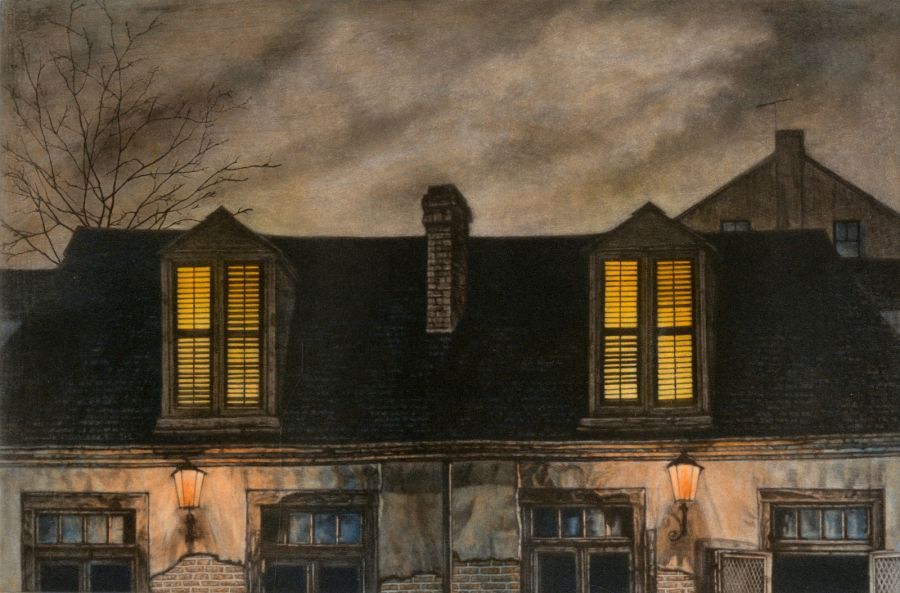color mezzotint and aquatint
2005
6 1/2 x 9 7/8
edition: 120
Retif and Salzer 88
signed in pencil.
Lafitte's Blacksmith Shop is a New Orleans landmark at 941 Bourbon St. Like most New Orleans legends, history of Lafitte's Blacksmith Shop is a gumbo of truth with French, Spanish, African, Cajun and American embellishments. Frederick Mershimer created this aquatint and mezzotint in 2005 in an edition of 120. It is #88 in the Retif/Salzer catalogue raissonne. Lafitte's Blacksmith Shop -- built between 1722 and 1732 by Nicolas Touze, is reputed to be the oldest structure used as a bar in the United States. In 1722, further building is recorded in a realty transfer set down by Don Andres Almonester. The structure and fence are in the old French Provincial Louis XV or Briquette-Entre-Poteauxe style used in French Louisiana. The building escaped two great fires at the turn of the 19th Century, due to slate roofing. Such slates are presently used by artists as canvases. Between 1772 and 1791, the property is believed to have been used by the Lafitte Brothers, Jean and Pierre as a New Orleans base for their Barataria smuggling operation. The legend is based on the fact that the property was owned by the family of Simon Duroche a.k.a. Castillon and the wily privateer Captain Rene Beluche. Castillon was a rather record-shy adventurer and entrepreneur. Captain Beluche commanded his ship "Spy" in Lafitte's Baratarian fleet. Although the owners of the property, Jean Baptiste Dominica Joly LaPorte probably lived on the premises, it is within reason that the Lafittes could have used the place as a city base for negotiations with potential buyers of their goods. It is unlikely that a wealthy Creole would agree to meet at home on Royal Street. The building at Bourbon St. and St. Phillip St. was probably regarded as a safe and convenient neutral ground.
Frederick Mershimer received a BFA from Carnegie Mellon University, where he majored in painting and drawing. After moving to New York in 1983, he began to study printmaking at The New School, Pratt Graphics Center (1984 – 1987) and Manhattan Graphics Center (1988 – 1992). Mershimer was initially drawn to the slow, direct and laborious mezzotint process, because it echoed his approach to drawing. In 2007, Stone and Press published a catalogue raisonné of his work, titled Frederick Mershimer Mezzotints 1984 – 2006. In 2007, he received an Artist Fellowship Grant from the New York Foundation for the Arts, followed by a 2009 Individual Support Grant from the Adolph and Esther Gottlieb Foundation.
COLLECTIONS
- The Brooklyn Museum of Art, Brooklyn, New York
- The British Museum, London
- The Cleveland Museum of Art, Cleveland, Ohio
- The Corcoran Gallery of Art, Washington, D.C.
- Historic New Orleans Collection, New Orleans, Louisiana
- The Flint Institute of Art Flint, Michigan
- Fogg Art Museum, Harvard University, Boston, Massachusetts
- Georgetown University Lauinger Library, Washington, D.C.
- Kalamazoo Institute of Arts Kalamazoo, Michigan
- Library of Congress, Washington, D.C.
- McNay Art Museum, San Antonio, Texas
- Minneapolis Institute of the Arts, Minneapolis, Minnesota
- Molloy College Art Gallery, Rockville Centre, New York
- Museum of the City of New York, New York, New York
- The National Museum of American Art-Smithsonian, Washington, D.C.
- New Orleans Museum of Art, New Orleans, Louisiana
- The New York Public Library, New York, New York
- Newark Public Library, Newark, New Jersey
- Purdue University Galleries, West Lafayette, Indiana
- Queens Museum of Art, Queens, New York
- RISD Museum/ Rhode Island School of Design, Providence, Rhode Island
- Spencer Museum of Art/The University of Kansas, Lawrence, Kansas
- Tampa Museum of Art, Tampa, Florida
- University of Arizona, Tucson, Arizona
- University of New Mexico, Albuquerque, New Mexico
- Wesleyan University, Middletown, Connecticut
- Wellesley College, Wellesley, Massachusetts
- The Whitney Museum of American Art, New York, New York
- Zimmerli Museum, Rutgers University, New Jersey



